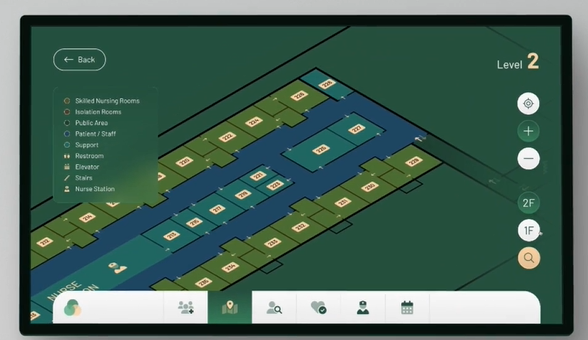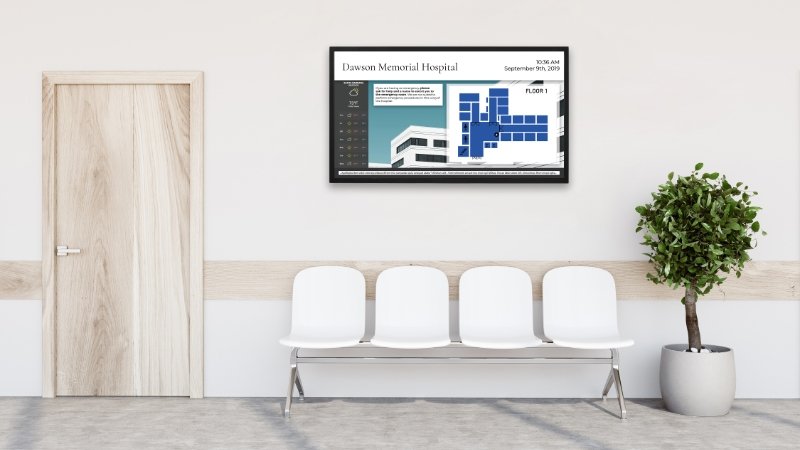How Digital Signage Can Improve Wayfinding in Hospitals
Did you know that hospitals that use digital wayfinding solutions experience a 25% reduction in missed appointments? More than 65% of patients reported that digital wayfinding solutions improved their hospital experience.

But all these should be no surprise to you, as hospitals can be confusing, especially if they are in large and complex facilities. This is why we bring a solution: digital signage wayfinding technology. These technologies allow patients and visitors to navigate hospitals more easily. They can help patients figure out where they are and direct them to the correct location. This will improve the patient’s experience and reduce the stress levels that patients and visitors go through while trying to find their way around a hospital.
Poor directions in a hospital also come at a cost, from the time staff spend directing lost patients to late arrivals and missed appointments. But we are here today to guide you to change. Let’s understand how you can leverage digital signage to improve hospital wayfinding.
Understanding Wayfinding in Hospitals
Wayfinding is a person’s ability to navigate around the hospital. A well-designed hospital should be able to tell you exactly where you are, where you want to go, and the fastest way of getting there. However, when addressing physical well-being, hospitals may tend to overlook the high levels of stress, anxiety, and uncertainty that come with being in a particular environment.
In these facilities, visitors get lost 30% of the time. Frustration and helplessness caused by being unable to locate a hospital department are among the top complaints in healthcare facilities, resulting in heightened stress and anxiety.
It also costs the patient money, leading to missed appointments, waiting in the wrong queues, and sometimes missing treatment. The staff also wastes time directing these patients to the fitting rooms.
Hospitals should seek wayfinding solutions to help visitors familiarize themselves with the environment. This will help save on costs and a great deal of time.
The Role of Digital Signage in Enhancing Wayfinding
Digital signage plays a critical role in helping with navigation within complex facilities. It consists of digital screens that can be placed in healthcare facilities and provide clear, easily accessible wayfinding information.
When investing in digital signage, you can display high-resolution maps, directional arrows, and textual information to guide your patients and visitors to the correct destination. It helps them efficiently locate clinics, patient rooms, and amenities and improves their overall facility experience.
Digital signage is also very flexible, allowing you to provide real-time updates, such as informing visitors of room changes, emergency alerts, and other important information. Digital signage ensures a secure and patient-centered environment.
To display this information, use lively colors and animated elements that ensure the wayfinding information is visually appealing and easily understandable. You can even provide a list of doctors, their departments, and the specific floors they are on, allowing visitors to avoid getting lost.
Strategic Placement of Digital Signage for Optimal Wayfinding
In places where you want to reduce stress and anxiety, like hospitals, you must be strategic while placing digital signage. In fact, statistics reveal that digital signage can reduce perceived wait times by 35%. So, it is essential that you strategically place the digital signage.
- Main entrances and lobbies: You can make your patients feel better by warmly welcoming them and introducing them to the facility. Then, provide clear directions on how to find their way around the facility.
- Corridors and hallways: At this point, it may mean the patient gets lost or needs further guidance. It is essential to be very clear and specific. Provide further instructions, clearly stating where the patient should proceed.
- Elevator Bank and Stairwell: Correctly represented graphics can provide the right direction. Maintain consistency in the symbols and graphics you use to avoid any conclusion.
Strategic placement of digital signage is critical as it enhances the customer experience and determines. Be very keen to provide the correct information while creating the video and images to display these screens.
Enhancing Patient and Visitor Experience with Digital Signage
According to healthcare statistics, 70% of healthcare facilities report increased customer satisfaction after adopting digital signage software. Staff communication and workflow efficiency also improved by 80%. So as you can see, it is more than a customer locating a doctor.
When you provide clear and factual information about directions, customers find it easy to follow and reach their destination without much hassle. Allowing for easy navigation in a complex facility is one of the best gifts you can give your patients. This will ensure that they remain optimistic about the services they will receive and minimize any frustration.
Additional Benefits of Digital Wayfinding Signage
World Health Organization (WHO) statistics show that at least 1.3 billion people have a disability. This means 16% of the world’s population requires support with their daily activities. As you would excerpt from a digital tool, it has integrated the prerequisites set by the ADA to include the needs of people with disabilities.

Digital signage has ensured this by having glare-free screens, an ADA-compliant mounting height, and high-contrast content. Additionally, it supports multilingualism, allowing it to be used in emergencies in different languages. The languages are, however, set to be simple, avoiding complex sentences, technical jargon, and idiomatic expressions.
Digital signage has video subtitles that allow streaming audiovisual content to accommodate people with hearing disabilities and those who want a quiet environment. These kinds of integration allow for easy direction while including everyone. It is a smooth way to streamline operations in these hospitals without hiring extra staff to give direction.
Future Trends in Digital Wayfinding for Hospitals
With the continuing advancements in technology, more changes are expected to elevate digital signage to another level. Although some of these trends are being integrated, we still expect a continued increase in digital signage to ensure wayfinding.
The trends include:
- Mobile app and social media integration: When digital wayfinding integrates with mobile apps like Instagram, Twitter, and YouTube, it will allow for personalized messaging, as hospitals will be able to gather valuable data and insights about the customer.
- Mobile device management will allow personalized updates, improved communication, and more straightforward directions. This will provide the hospitals with convenience, flexibility, and time management when providing real-time updates and changes.
- Interactive touch screen capabilities: In the near future, digital signage’s digital wayfinding features will allow hospitals to create a more interactive and improved experience by allowing customers to interact with these screens, access additional information, and even ask the system questions directly.
If the digital integration in wayfinding is enhanced, we will see hospitals where customers are given a personalized experience, increased engagement and awareness, and real-time updates. This will improve the hospitals’ efficiency and allow the customers to manage their help effectively.
In Conclusion
Digital signage has been a real game changer in hospitals. Instead of staff wasting time guiding patients to different hospital departments, every patient can fend for themselves. It has also streamlined communication, allowing patients to wait in line without feeling that they have been there too long. With the improvement of technology and the digitalization of every facility, adopting digital wayfinding is the only way to improve the customer experience. Adopt digital wayfinding and stay relevant in the industry today!



